The first day in Tokyo was disorientating – all neon, gadgets and extreme politeness – but I was surprised to find that I have a lot in common with the Japanese because they’re bonkers about food. Rick Stein, restaurateur

PART 1 – TOKYO
Konnichiwa! It’s been 20 years since my first visit, and now I’m back to the Land of the Rising Sun. For David, it was a dream come true. Most importantly, it was perfectly timed for Sakura ~ Cherry Blossom time in Japan, and luckily, the Japanese deities came through; our arrival coincided with a breathtaking show of the Sakura at its peak pink bloom.
Each year’s pending bloom is well-researched, and following the experts, the trip was planned in great detail over the past two years, to best experience Sakura. We’ve got an incredible 17 days ahead of us to travel central Japan and witness this phenomenon in all its glory.
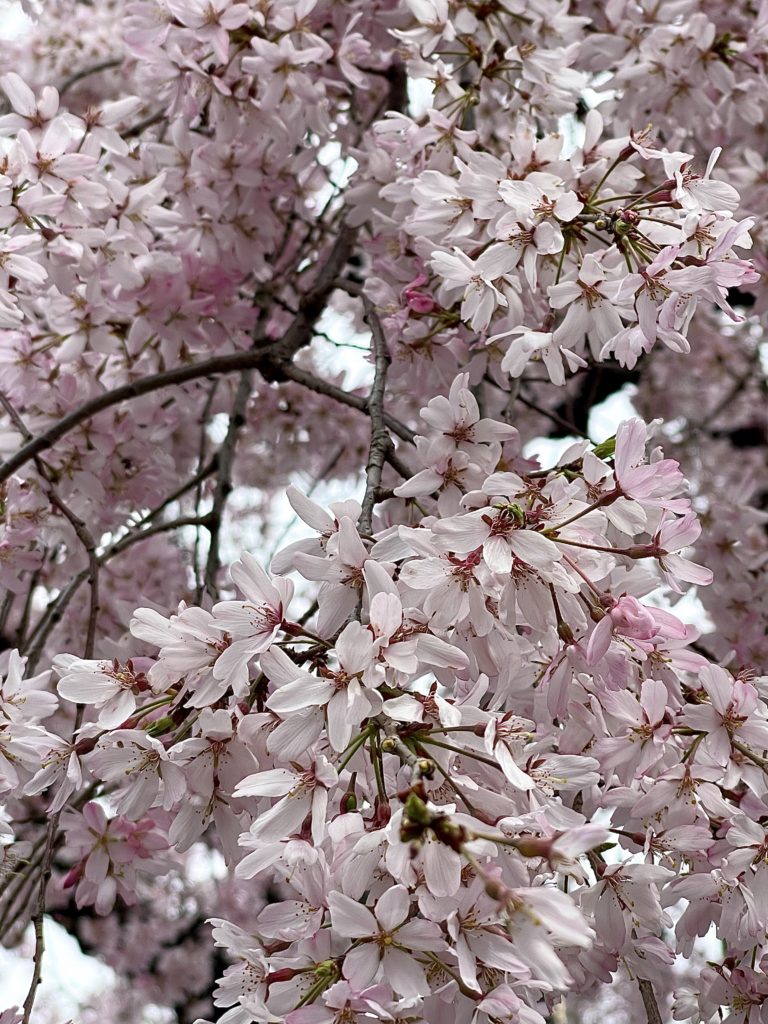

And, just as important, to discover and devour the incredible culinary traditions of Washoku (Japanese cuisine). It was my desire to “ramen” my way through the country. Add some sake here and there, and we’ve got some delicious and serious eating and drinking ahead of us. It didn’t disappoint.
Japan has only recently reopened its borders, allowing our trip to finally become reality via ANA ~ LAX. The comforts of their new seat configuration, known as “The Room,” made the long flight most enjoyable. Best ramen at 38,000 feet; and we’re off to a great start.
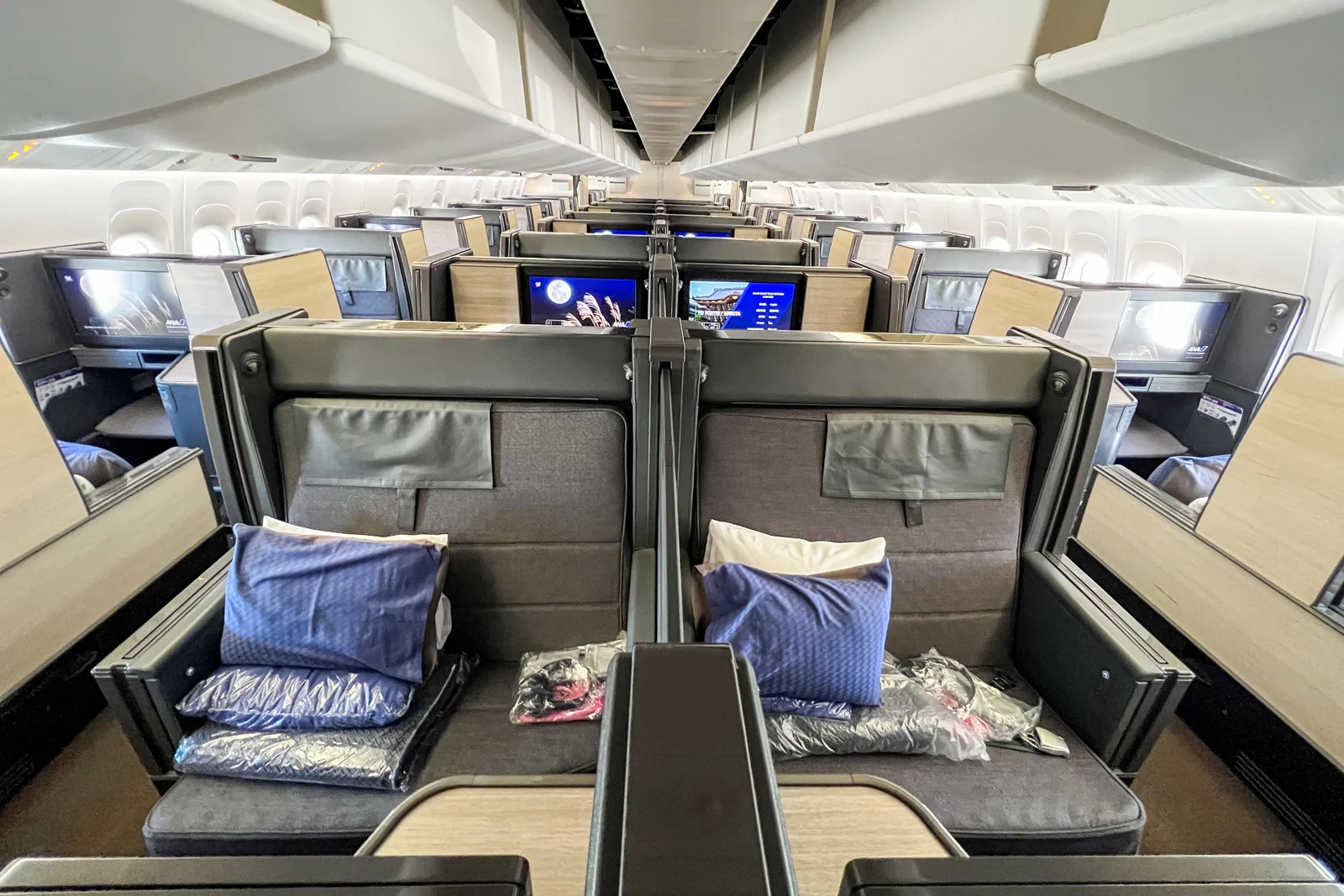
Pinching ourselves, we’ve landed at Tokyo’s Haneda Airport, a bit chaotic at 5:30am, as Japan requires a lot of QR codes, proof of vaccination and immigration and customs checks. Prior online preparations enabled us to breeze through the confusion and begin our Japan adventure.
Tokyo is the world’s most populated city, with a total urban population of around 40 million! It has the second largest urban economy worldwide after New York City. The bustling metropolis is known for its cutting-edge technology, fashion, arts, and cuisine, as well as its unique blend of traditional and modern culture. Tokyo Metro allows easy access to it all (once you get it mastered).
Side bit of information about who’s wearing facemasks in Tokyo: Japanese = 98%, Foreigners = 2% (if that). We got thanked by our guides when they saw us wearing masks.
We settled into the Park Hotel in Tokyo’s Minato City on its Eastside. Its lobby is perched on the 25th floor of the Shimada Building, and our 31st floor room provides a panoramic view of the nearby Sumida River and Tokyo Bay off in the distance. It’s a modern hotel, and caters to foreigners, but we’re looking forward to our upcoming accommodations in traditional Japanese inns and Ryokans along the way.
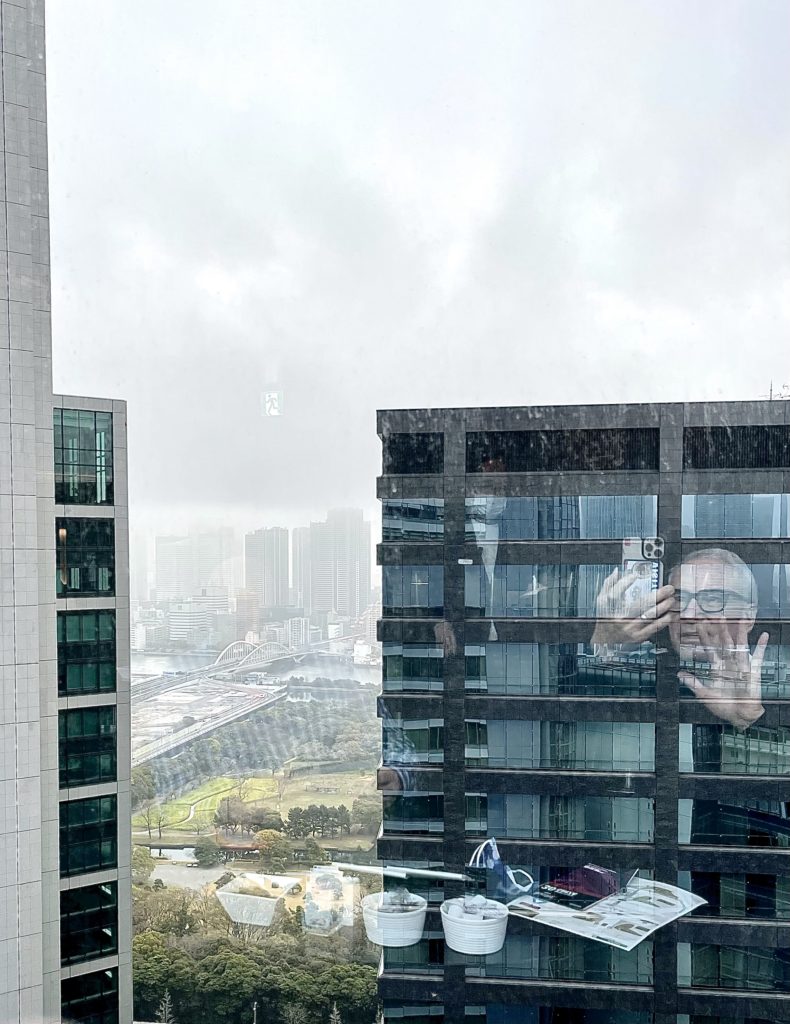


Right away we’re exposed to the arts; a delightful surprise was discovering the hotel had been transformed into a veritable art gallery. Its corridor walls featured modern artworks on all its floors. We’d partake of an art crawl and admired some really fine art throughout our stay. Several pieces caught our eye, but not our wallets.
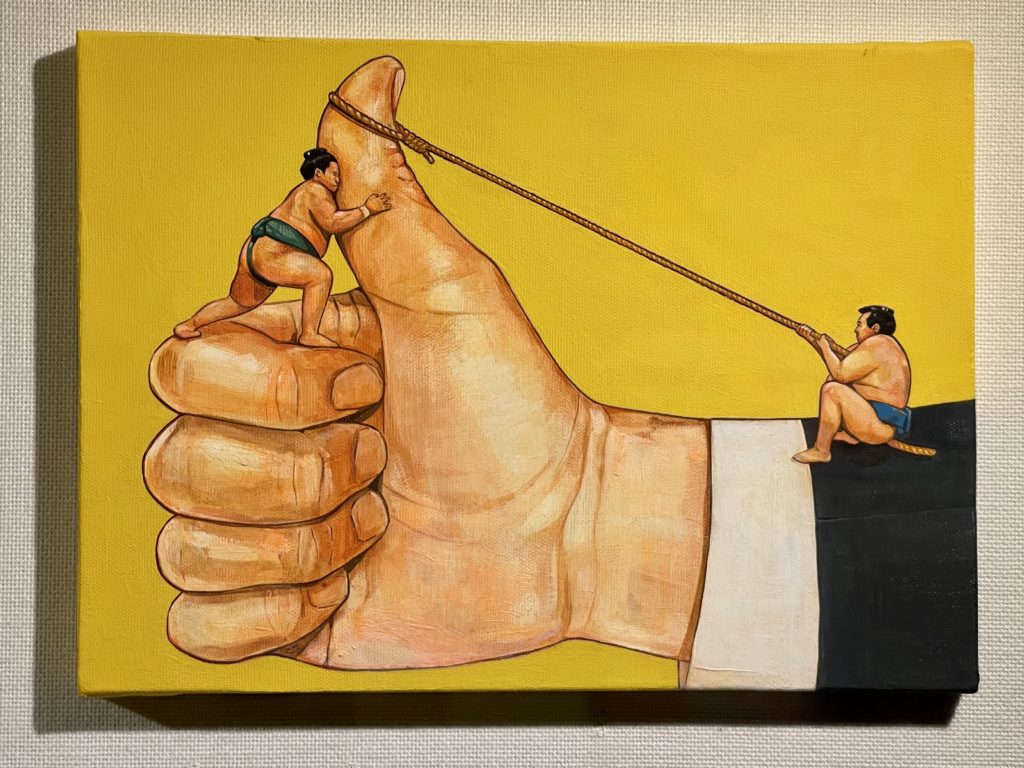
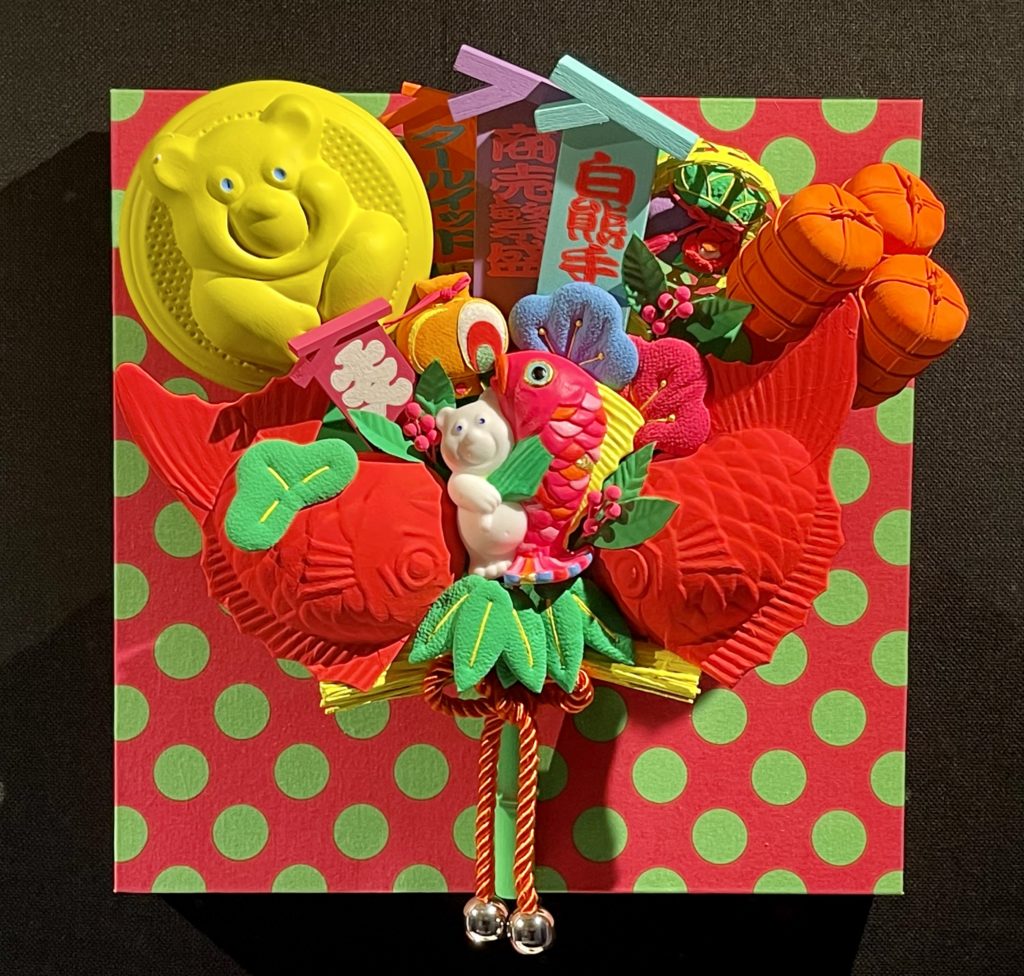
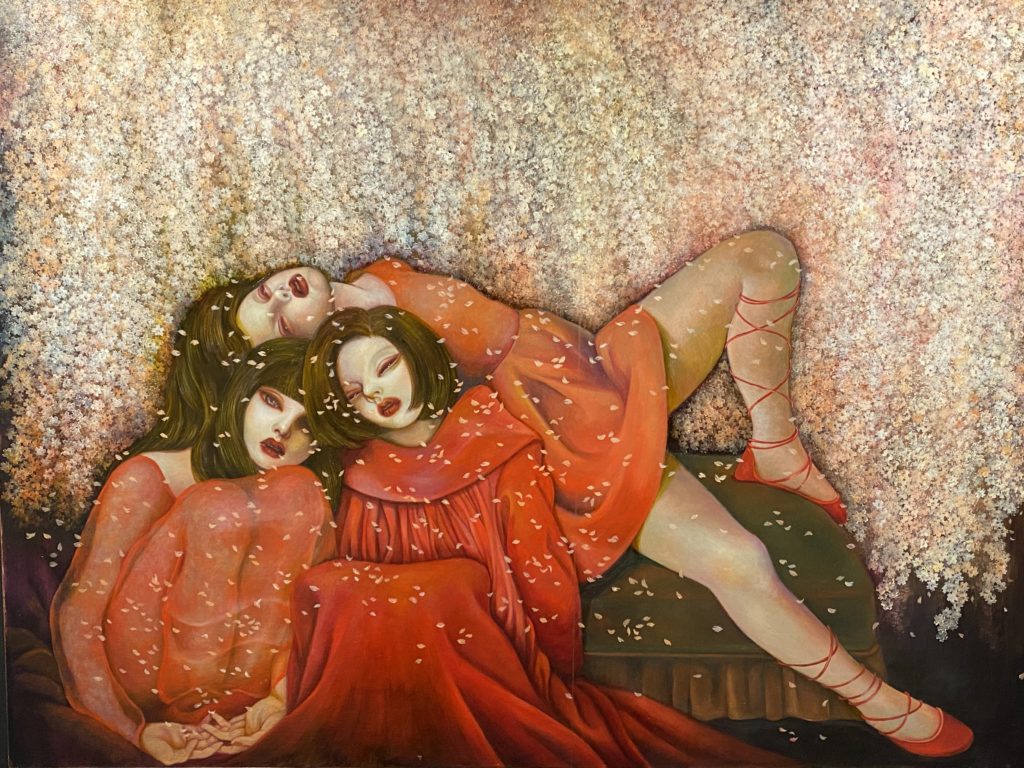
We’ve got the afternoon ahead of us; winging it, we head out to explore this sprawling metropolis on our own, since our official tour starts tomorrow. It’s a rainy day, but we’re well rested and raring-to-GO!
Tokyo’s popular attractions include its vibrant shopping and entertainment districts: Ginza, Shibuya, and Shinjuku. These areas are filled with department stores, boutiques, restaurants, and nightclubs, offering something for every taste. We’ll get to all three over time, but first we check out Ginza.
Tokyo’s Metro subway is right up there in the list of world’s best, and with a bit of patience and persistence, we’re determined to dissect it and conquer it. Thankfully, English is available throughout.
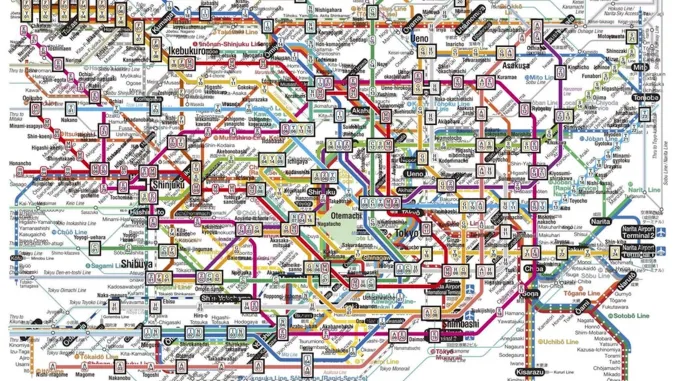
The Ginza is all it’s said to be ~ think Fifth Avenue or Regent Street. The streets are a veritable fashion runway with smartly dressed Japanese women (and gents) strutting their stuff; modern or traditional.
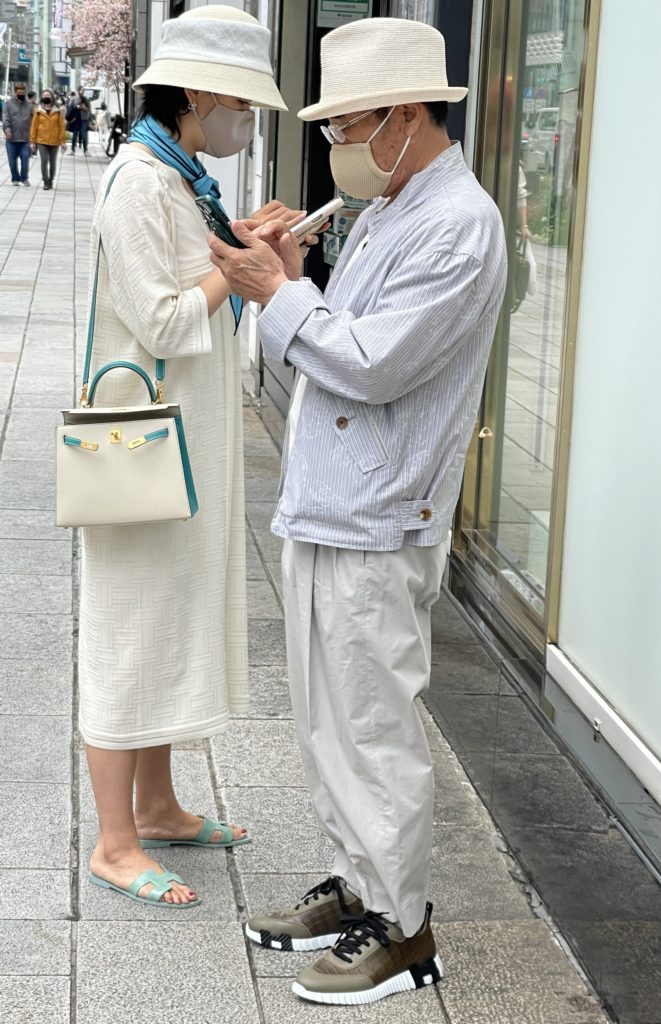
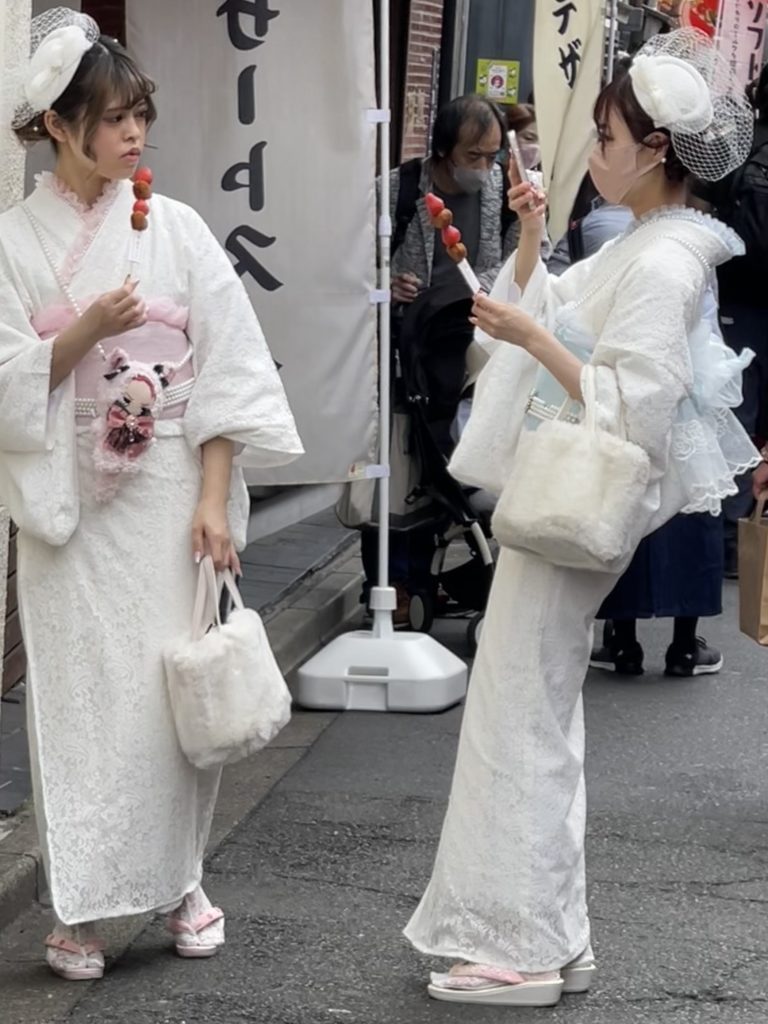
We window shopped under a light rain. Here, too is our first up close view of the famous pale pink cherry blossoms, and we couldn’t be more delighted and thrilled to be strolling along beneath these beauties.

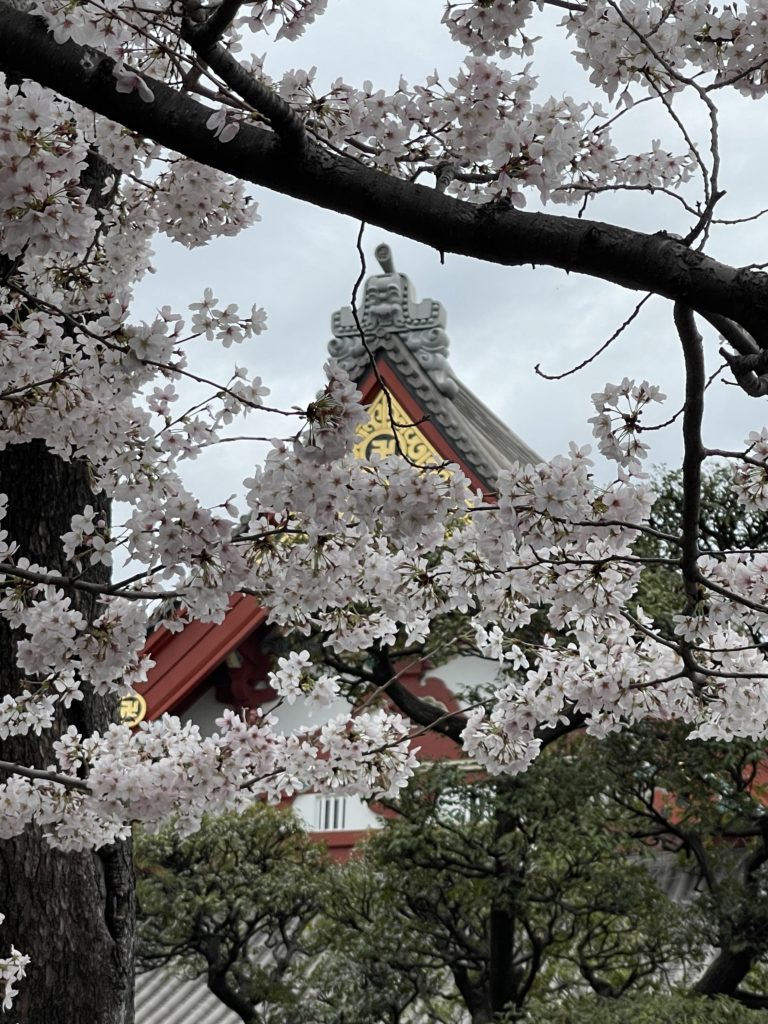
A quick history bit: Tokyo originally was a small fishing village named Edo. The city became politically prominent in 1603, when it became the seat of the Tokugawa shogunate. By the mid-18th century, Edo was one of the most populous cities in the world. Following the Meiji Restoration of 1868, the Edo Period’s 260 years ended when imperial rule was restored. The Emperor then moved to Edo, which was renamed Tokyo.
David knows my love for ramen and in his food and dining research, he found the incredible “Tokyo Ramen Street.” It’s a subterranean passageway collection of well-curated, renowned ramen shops gathered together and tucked down below in the labyrinth of the humongous Tokyo Station.
It was close by Ginza, and being a bit chilly, and steadily raining, nothing seemed more comforting than a steaming bowl of ramen. “Go where the lines are” – Rokurinsha’s long queue clearly signaled to us which way to go and wait. And wait we did, on the marked path that provided us the waiting time at our feet. It was well worth it.
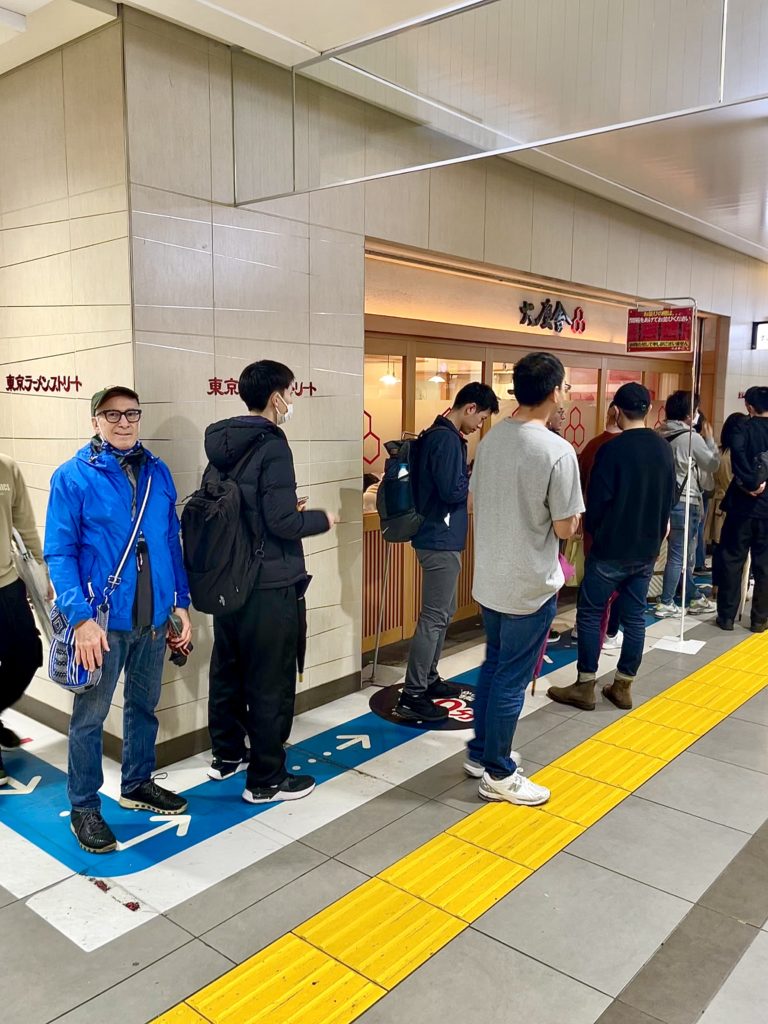
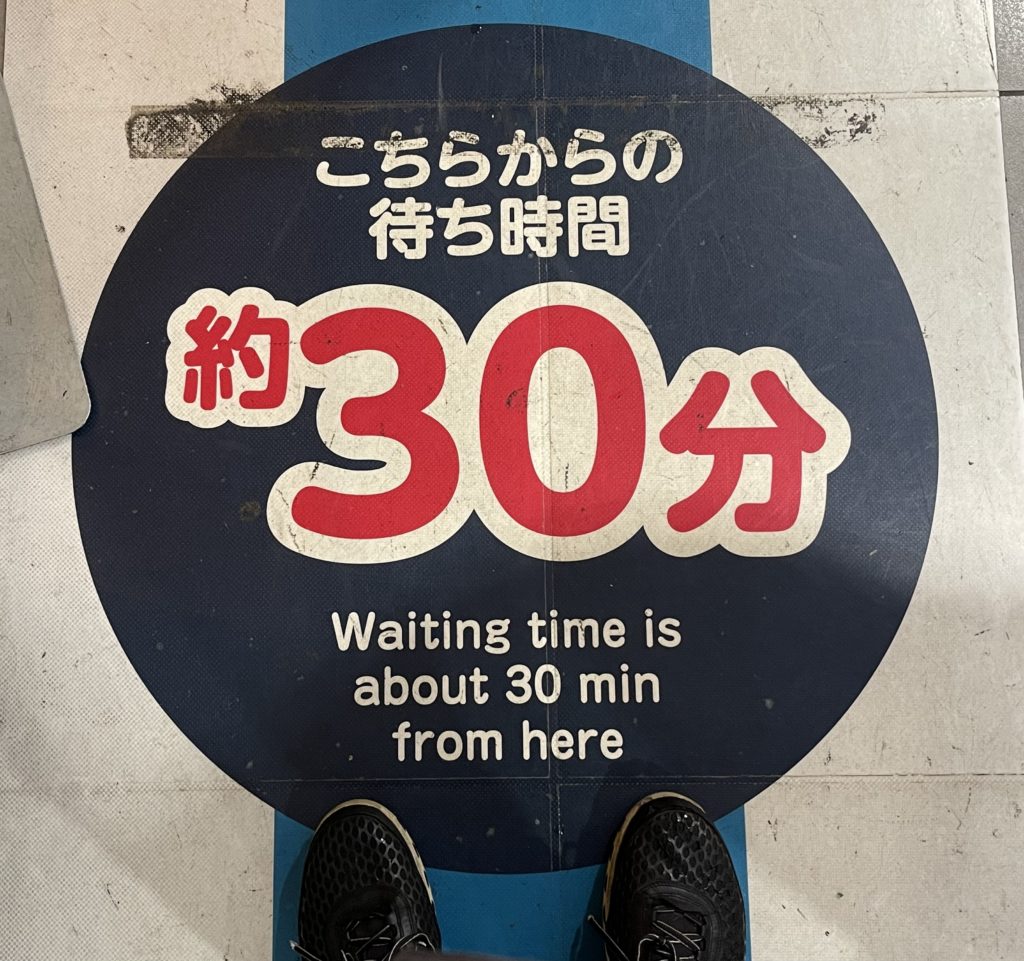
We got a quick education in Japanese food ordering: first place your order from the vending machine found up front. Photos provide all the selections. Luckily, a server lent us a hand – literally, by pointing out the popular specialties of the house. Add-ons are then easily chosen if you desire.
So, you pick and choose what you want to eat, pay and a stub or ticket is issued, then given to the server, and voilà, your food appears. Another innovative and very efficient system by the Japanese. It’s an Ina Garten, the Barefoot Contessa, moment ~ “How easy is that?!”
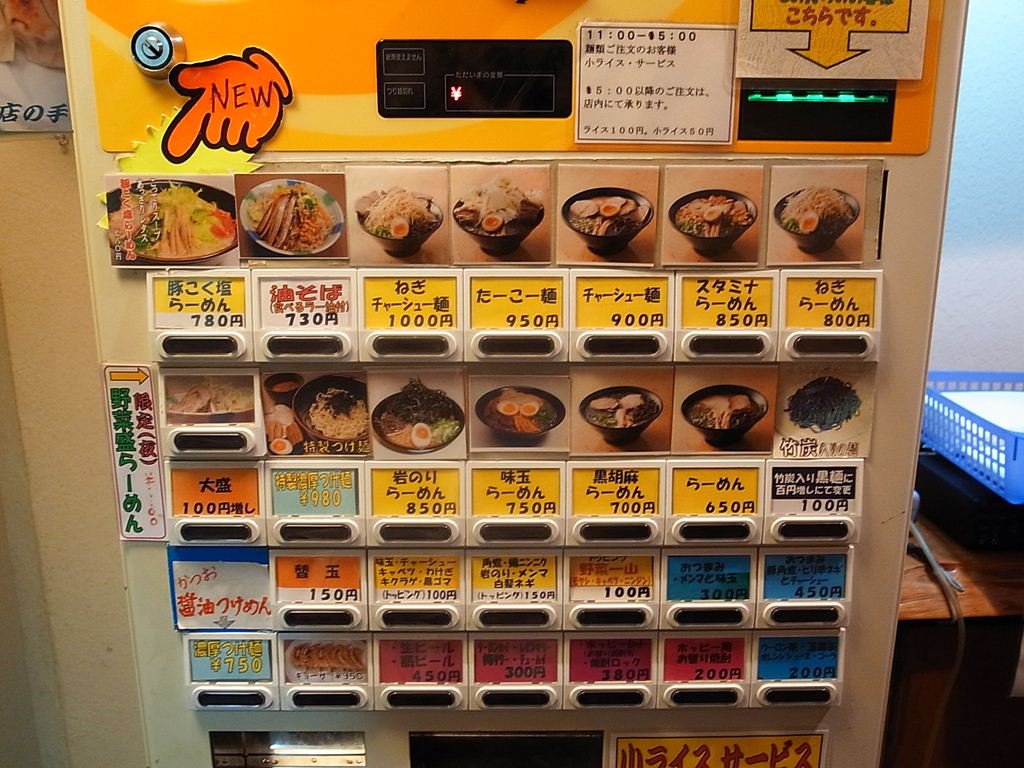
We’re packed in like sardines in the small dining space. A few minutes later two bowls arrive: one of just plain, fat soba noodles and the other of Rokurinsha’s famous, long simmered, tasty, super-thick rich pork, chicken and seafood broth; with slices of pork belly and other side ingredients and unrecognizable components. It’s slurp time ~ let’s get at it!
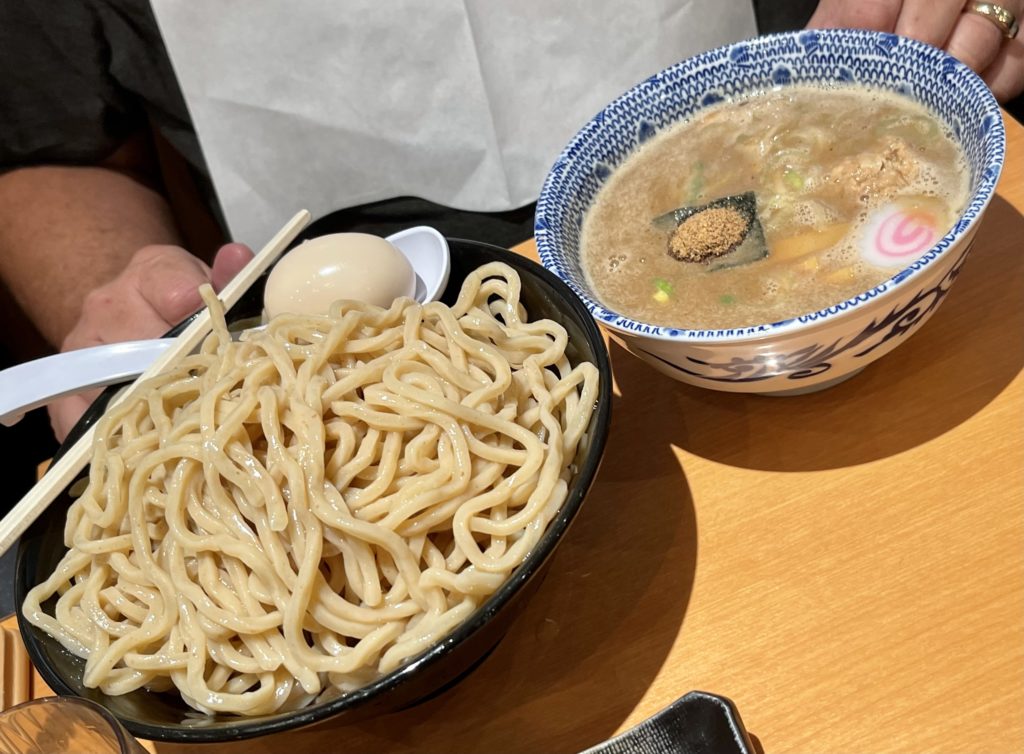
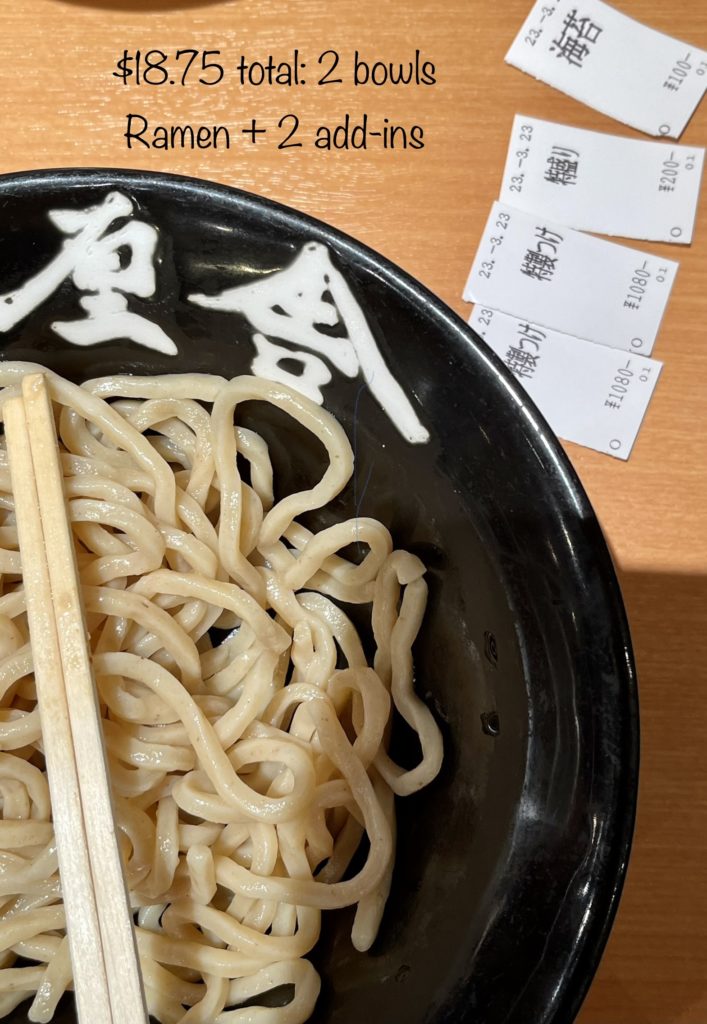
Portions are generous, and for $8.00 a bowl, we satiated ourselves. However, unlike our fellow Japanese diners, we couldn’t finish it off. FYI … there’s no tipping in Japan.
Imagine it and you can find it at Tokyo Station, a “station-city.” It’s the largest and busiest station in Japan, with more than 4,000 trains arriving/departing daily. That translates to more than half a million people, people! It’s a marvel to witness, as we wandered aimlessly, walking off our full bellies, and slowly taking in all the mishigas going on around us. Smartly, we keep to the sides and let the world quickly zoom by us.
There’s a labyrinth of endless shops and restaurants to service all that humanity. And only in Tokyo ~ there’s the Tokyo Character Street. Here you’ll find a plethora of popular Japanese anime characters, each with their own shop full of tchotchkes.
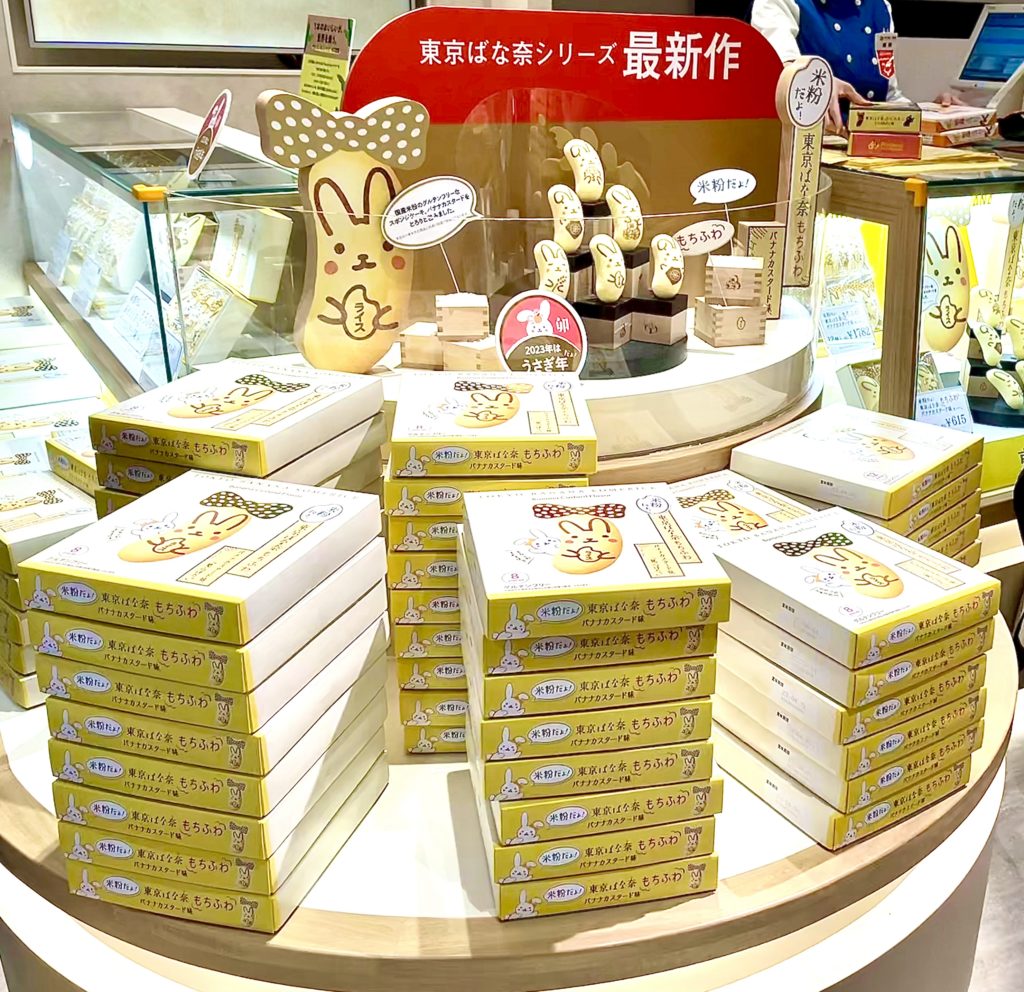
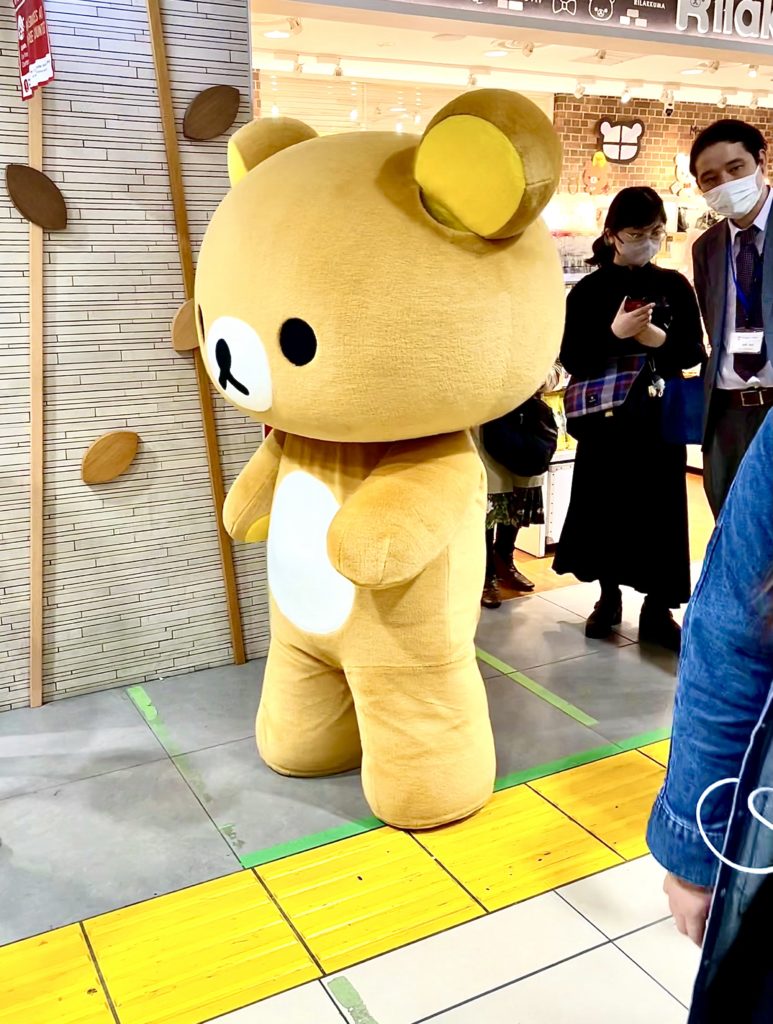
Young kids (and adults, too) are shopping like mad, dressed and accessorized to the hilt; a constant parade of contemporary fashions.
And, if you time it right, you can have a photo taken with a live character. David bought a fun, zip-pull Shinkansen trinket from the Snoopy shop that I’m sure he’ll cherish forever.
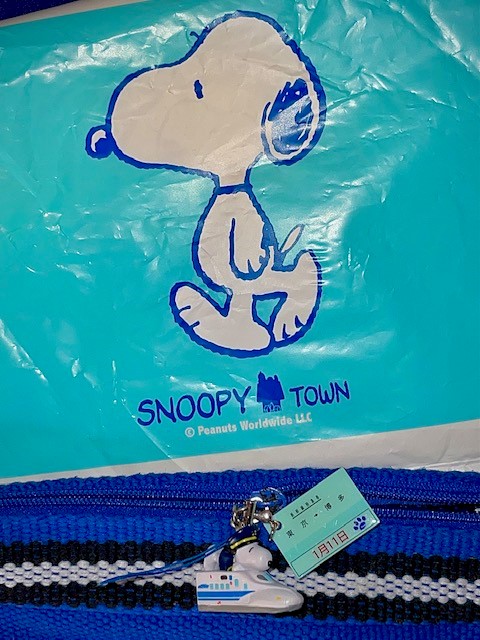
After our eating/shopping excursion, it was time to resurface for some air and eventually landed in Takashimaya, one of the premier retailers in Japan, an upscale luxury department store chockablock with world-renowned boutiques scattered through its six stories of fashion, and a fabulous food hall. It’s a “couture foodie” experience – the displays have you salivating as you walk by.


Though stuffed with ramen, the gelato counter beckoned (there’s always room for gelato). It’s an outpost of the famous Italian Venchi chocolate producer. A few licks in, I’m speechless; my strawberry and chocolate scoops were intensely flavorful. It’s as if I was taking a bite of a sweet, ripe strawberry and biting into a nib of cocoa.
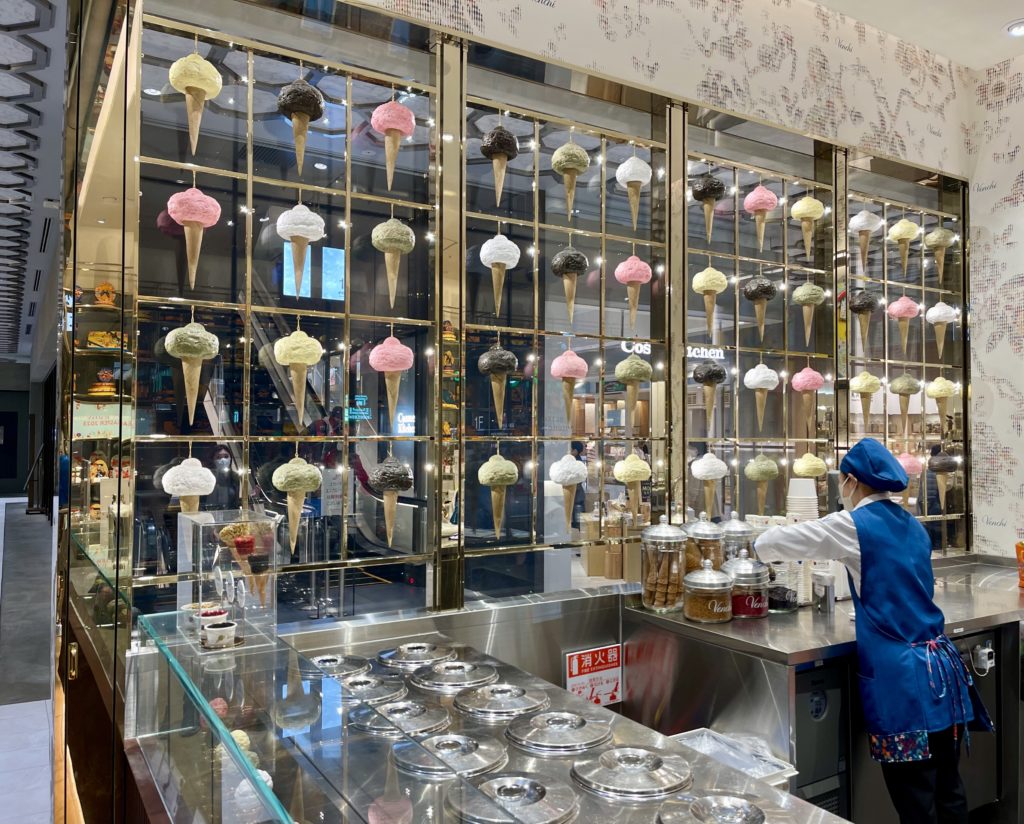
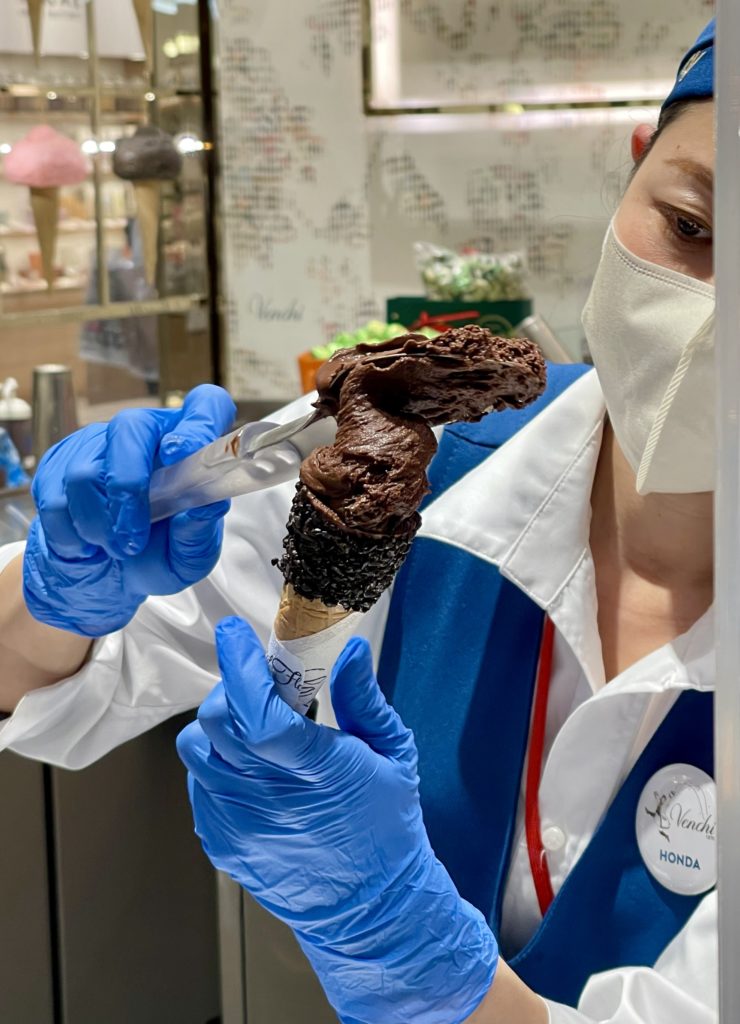

Today we got a small taste of Tokyo and had fun taking it all in on the streets and subways to get a feeling for what lies ahead.
Day Two and now our well-planned, scheduled tour comes to fruition. Kyoko will be our local guide. She’s a lovely, cheerful woman, and begins leading us around the city at breakneck speed.
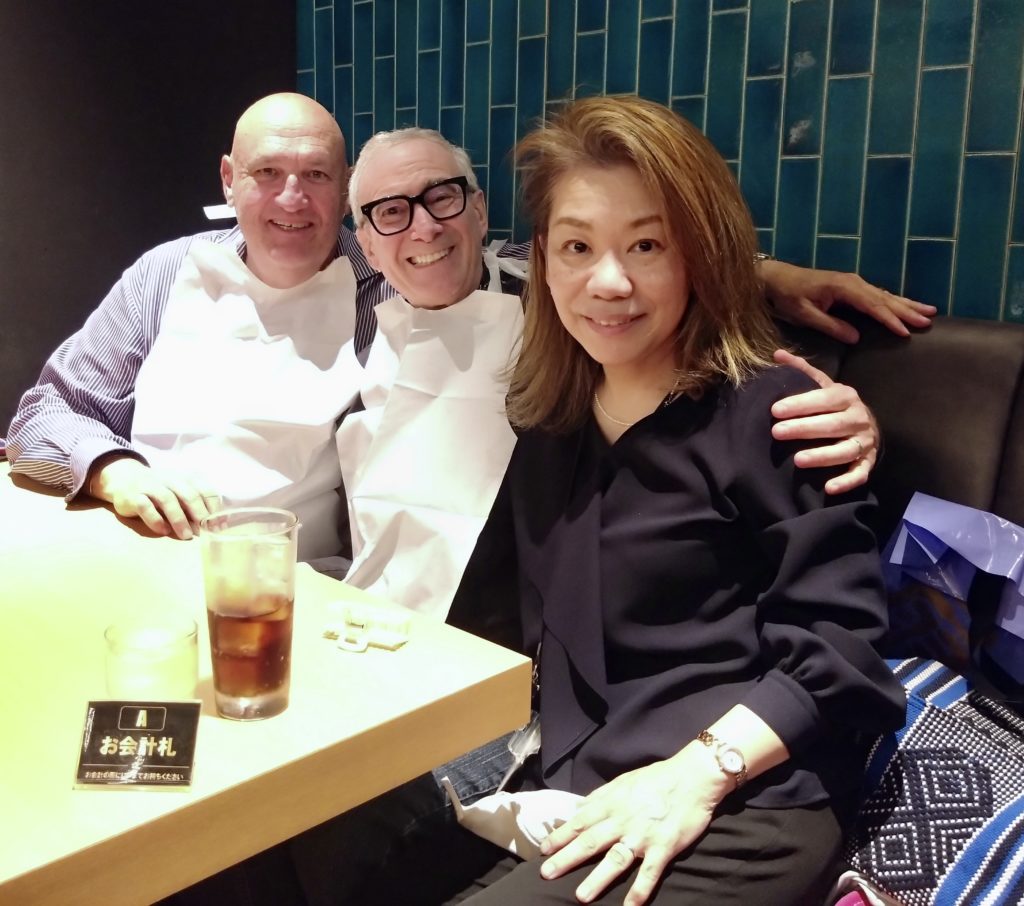
The Tokyo Imperial Palace is the main residence of the Emperor of Japan. It’s a large park-like area containing several buildings, and was built upon the site of the old Edo Castle. We walked through the gardens and two side gates, admiring the high fortifications, the castle in the distance and the blooming cherry blossoms. The palace is open to visitors on only two occasions: January 2 (New Year’s Greeting) and February 23 (Emperor’s Birthday).

Back on the Metro, our next stop is the Buddhist Sensō-ji Temple, the oldest and most significant temples in Japan. To get to it, we had to make our way through the bustling Nakamise-Dori, the street of shops, dating to the early 18th-century, leading from the Thunder Gate to the temple itself.
The shops are part of a long tradition of selling to pilgrims making their way to Sensō-ji Temple. Here, too you can satisfy your inner Godzilla urges with plenty of souvenirs of the famed “King of the Monsters.”
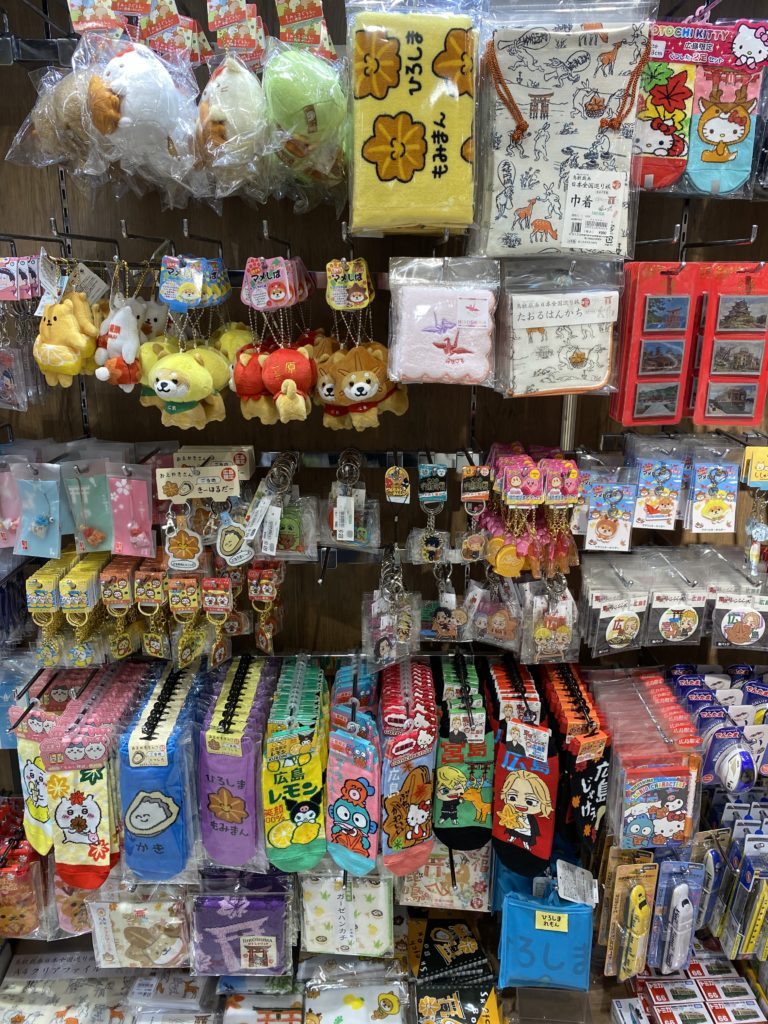
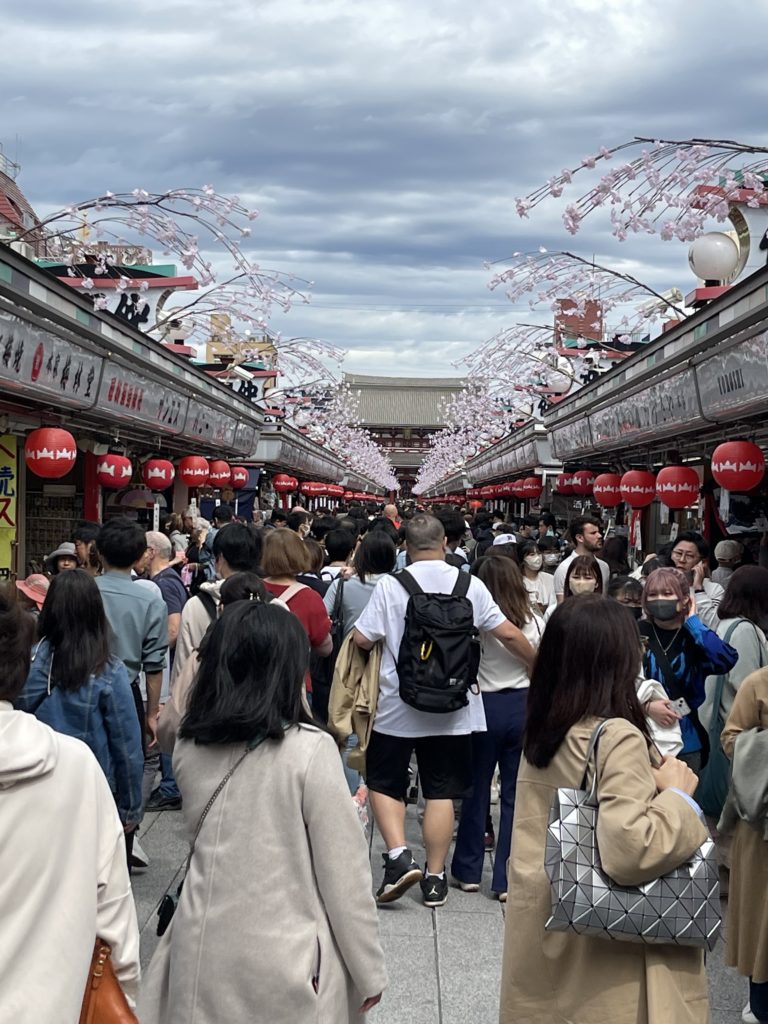
Sensō-ji was founded in 646 A.D., and is one of the most widely visited religious sites in the world. The temple is dedicated to Kannon, the bodhisattva of compassion. According to legend, a statue of the Kannon was found in the Sumida River in 628 A.D by two fishermen.
During World War II, the temple was bombed and destroyed. It was rebuilt later and is a symbol of rebirth and peace to the Japanese people.
Dominating the entrance to the temple is the Kaminarimon or “Thunder Gate”. This imposing Buddhist structure features a massive paper lantern dramatically painted in vivid red-and-black tones to suggest thunderclouds and lightning.
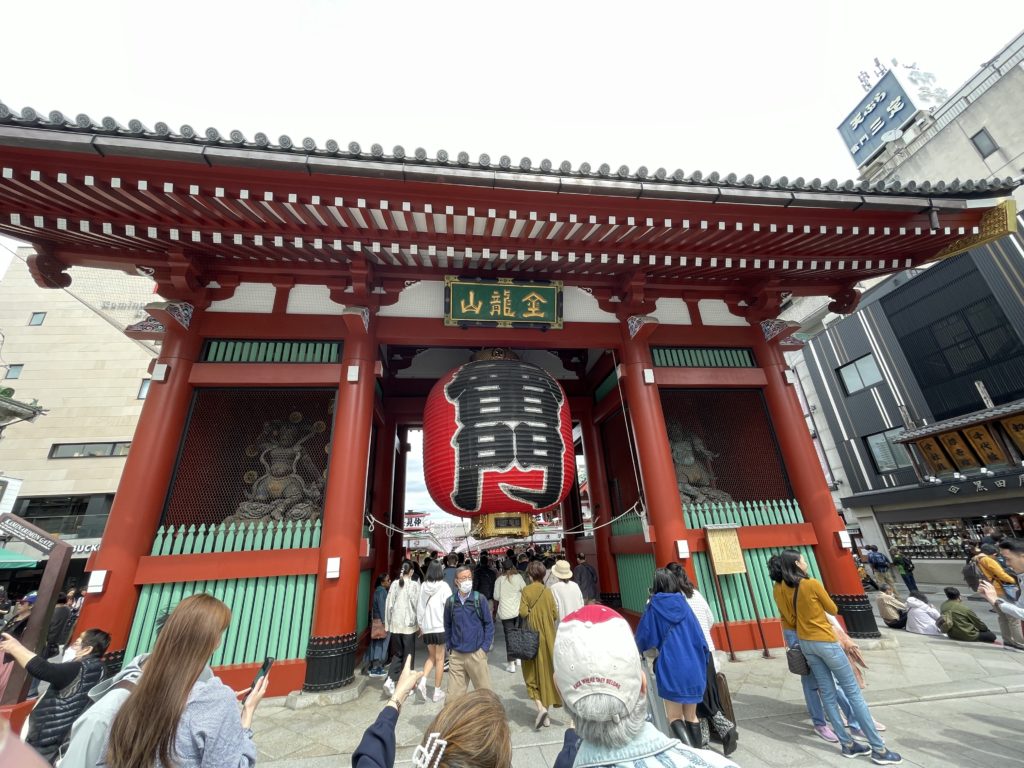
The inner complex includes a stately, five-story pagoda and the main hall. Within the temple itself, and at many places on its approach, there are o-mikuji stalls.
For a suggested donation of one hundred yen (75 cents), visitors may consult the oracle and receive divine answers to their wishes. This is done by shaking out a wooden stick from a metal cylinder; the stick reveals a number on it, which you then match to the corresponding numbered box on the wall; there you receive your fortune. With relief, let’s just say I have a fortunate future ahead.
The Sumida River Walk is a short stroll from the temple, and is one of the best places to experience Sakura (Cherry Blossoms). Hundreds of trees are planted by the riverside, turning the horizon a soft, pale pink. Even with a moody, misty atmosphere, it was breathtaking. We joined the promenade and savored the magical moment.
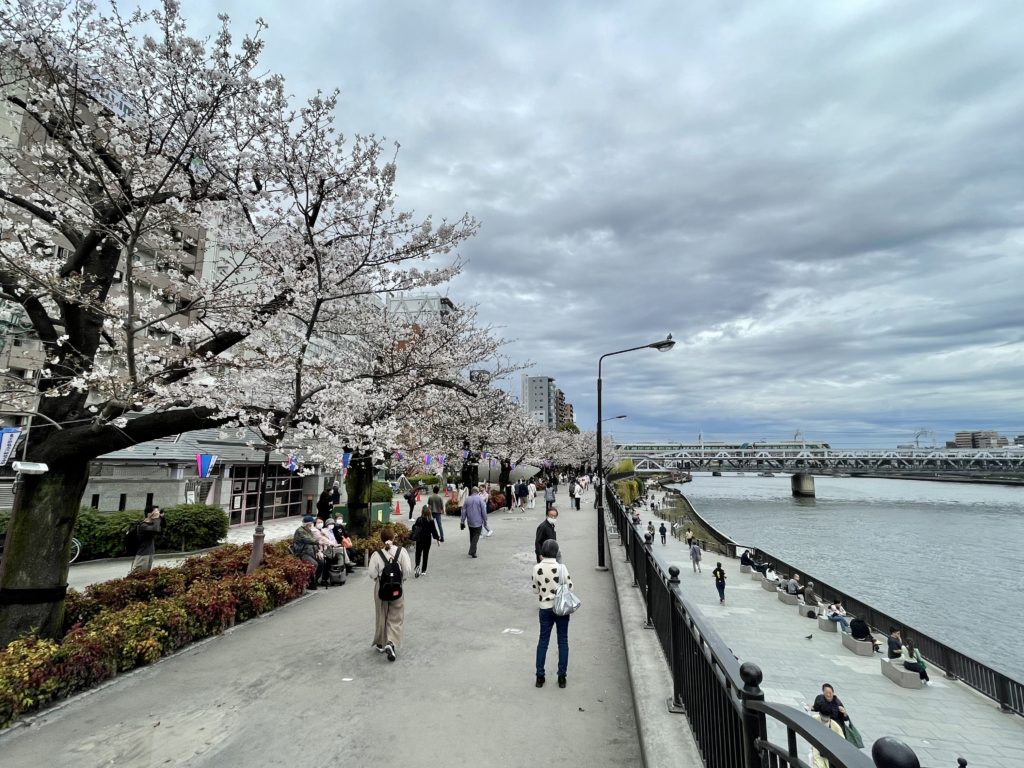
March 16 was this year’s prediction for the trees to start blooming, peaking on the 24th (today was March 24th!); another week, and we’d have missed the boat; instead we’re enjoying them in full bloom. How lucky are we?!
Kyoko will have us back on the metro soon enough, but first, it’s ramen time! She takes us to her favorite shop. Ramen noodles generally remain the same, but the style and subtlety of the broth changes from stand to stand. Here, I’m not disappointed and thoroughly enjoyed another slurping session.
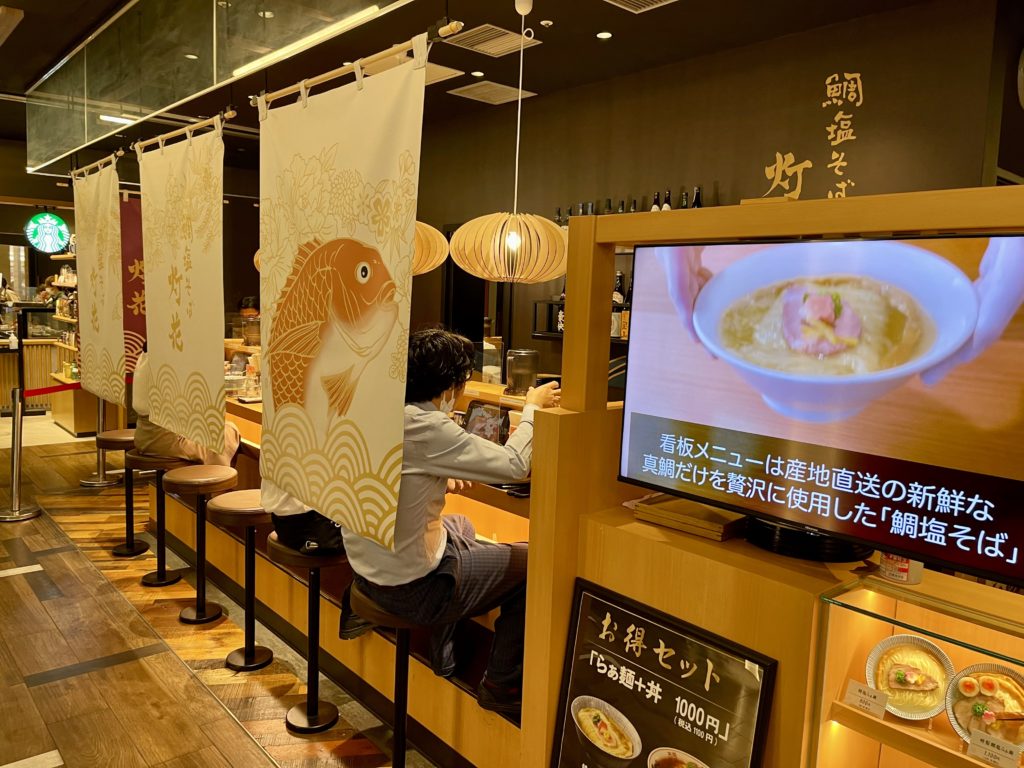
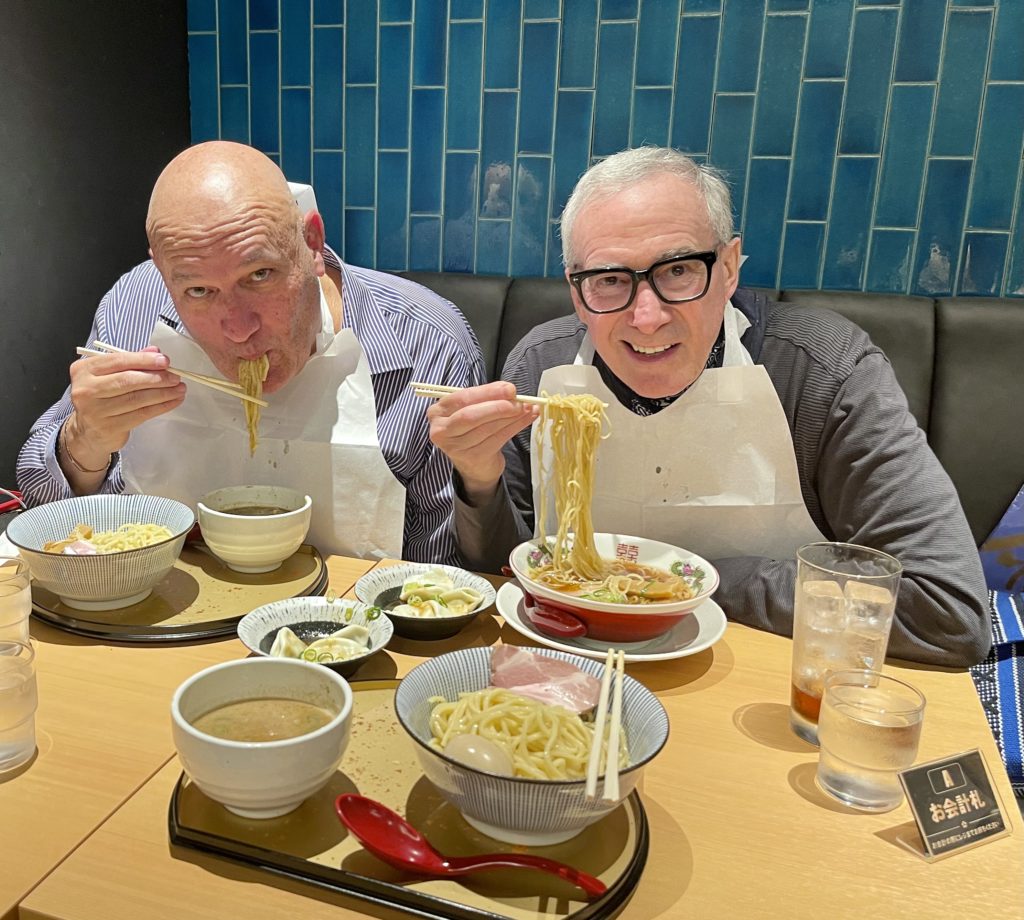
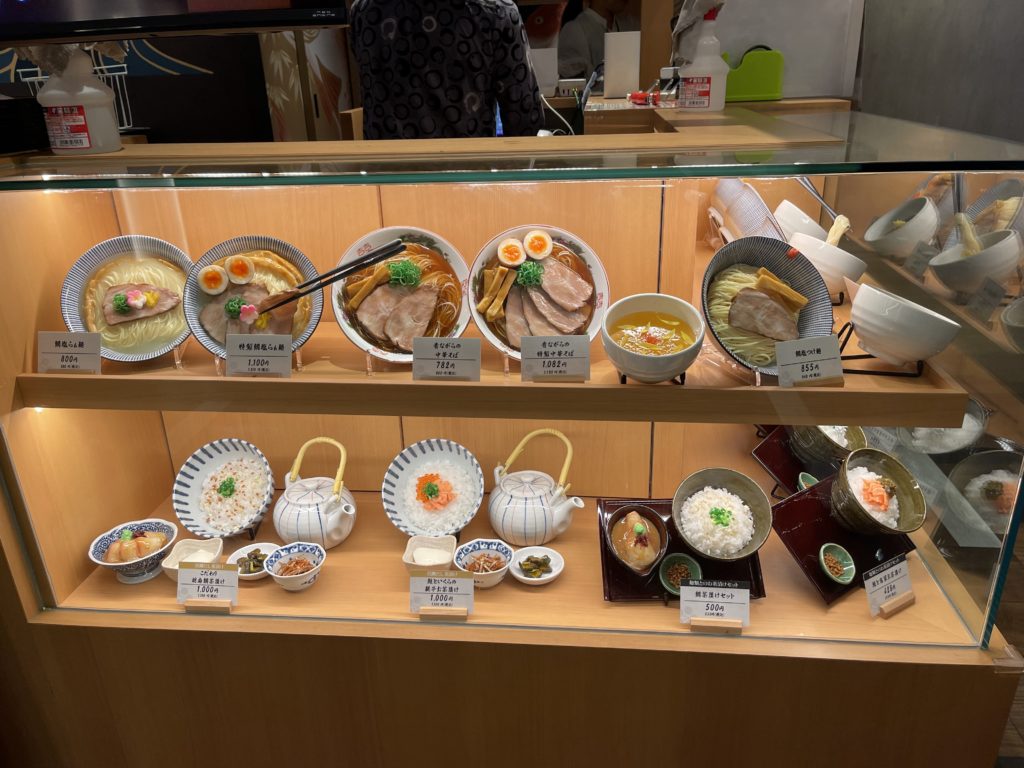
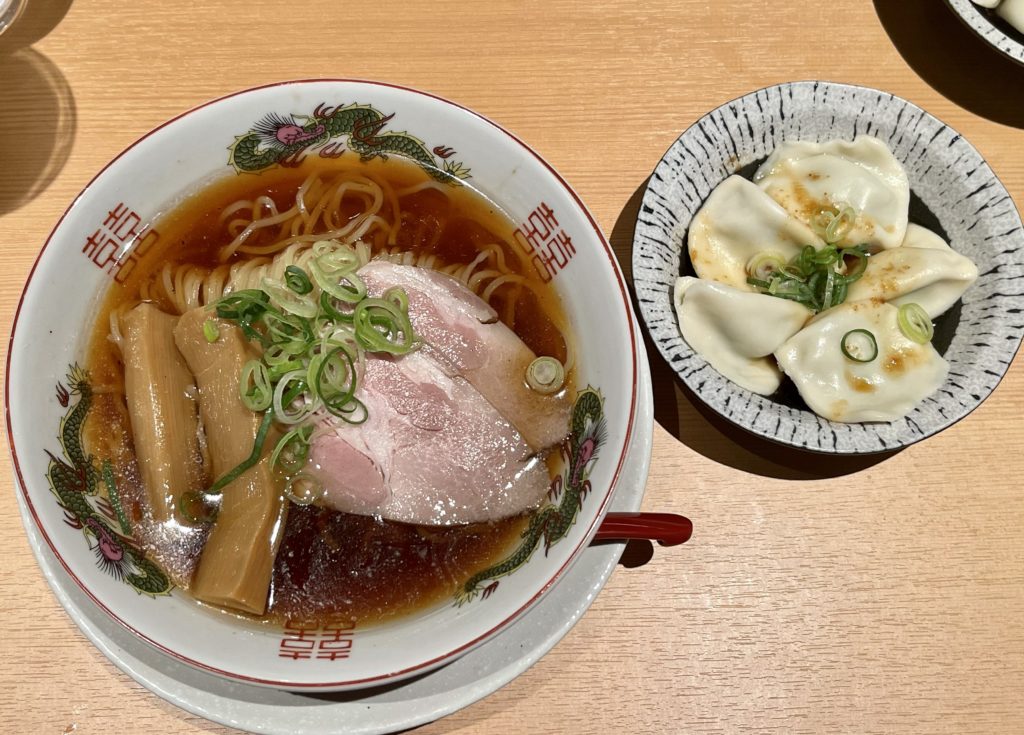
Up next is a total surprise – visiting the shop of a master glass carver and the technique known as Edo kiriko. It’s the most famous glass craftwork in Japan.
Kiriko means “cut glass” so its name means “cut glass from the city of Edo.” Originally, patterns were cut on a transparent and colorless glass surface. However, new techniques were introduced during the Meiji period, 1868-1912.

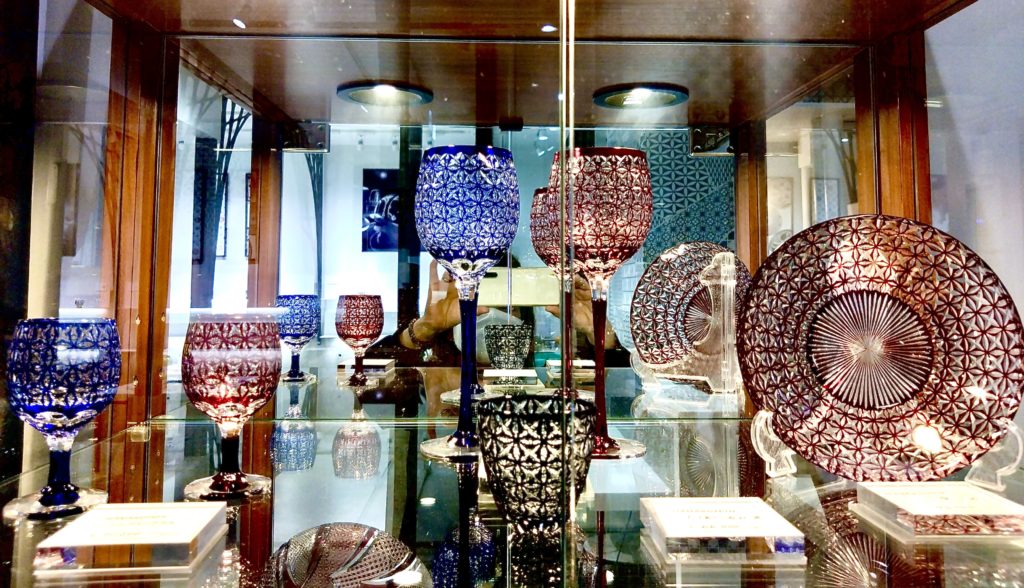
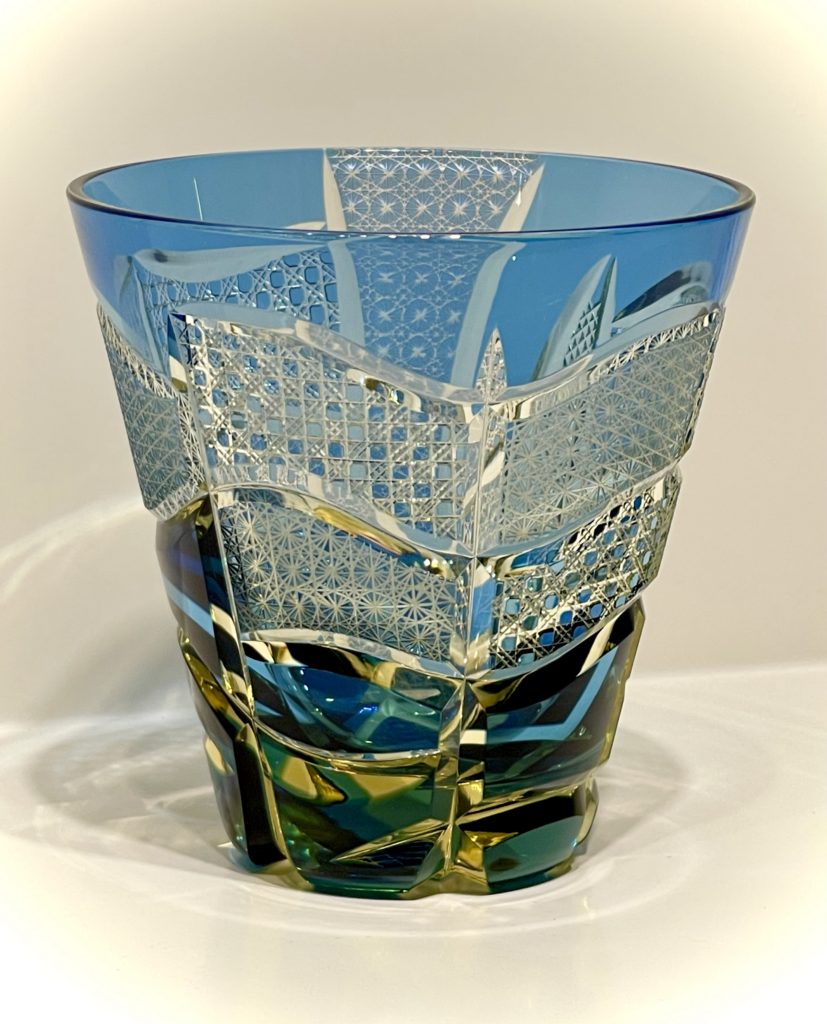
Today, Edo Kiriko is known for its intricate designs cut into lustrous blue, red, or other colored glass. We were given a small demonstration by a patient Japanese expert on the steps that it takes for this type of glass carving to become a work of art.
Then it was time for us to pick a design pattern and color; thinking that it was just going to be another demonstration, but no – we were going to etch the glass ourselves! And guess what – I had chosen the most difficult, and the most beautiful of all the choices presented.
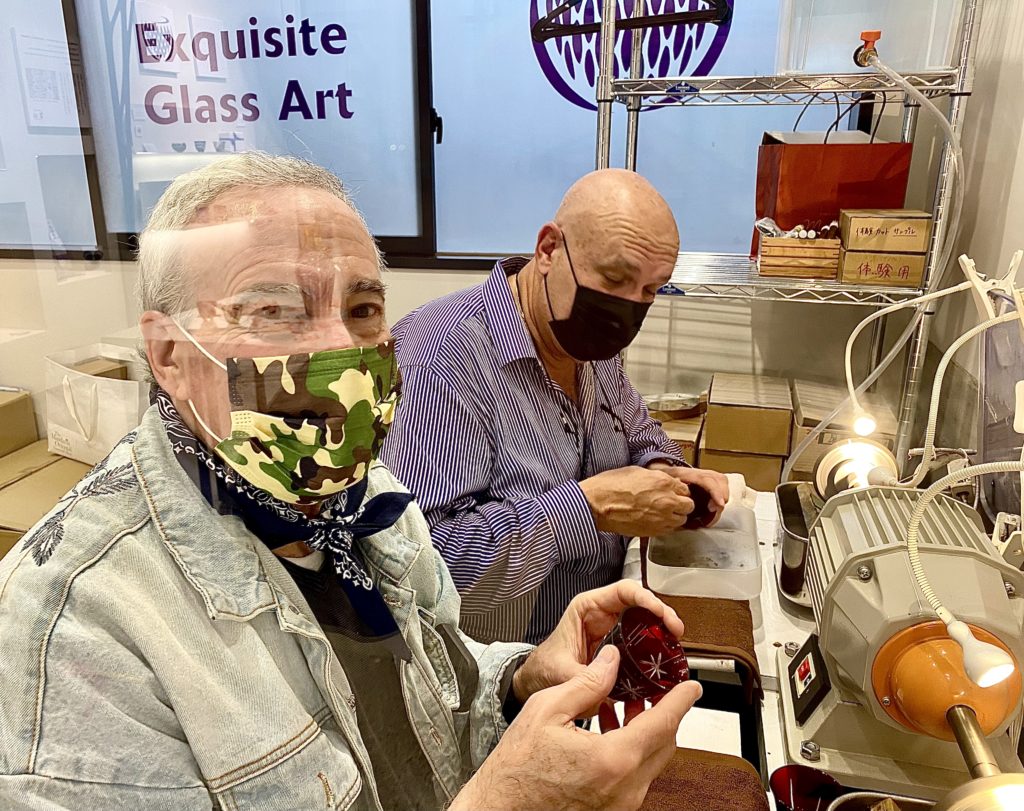
For the next hour it was total concentration as we carefully and nervously etched our glass. The result: a one-of-a-kind sample, not to be replicated anywhere in the world. Our little glasses may not compare to the exquisite pieces being sold in the shop, but we felt like accomplished artisans. I’m sure mastery of this craft takes decades to build and hone.
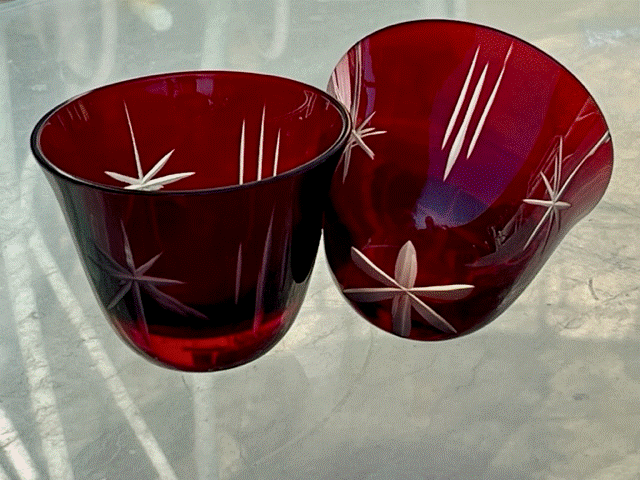
What a fun and great conclusion to this day in Tokyo … off to Hakone tomorrow via Shinkansen (aka Bullet Train).

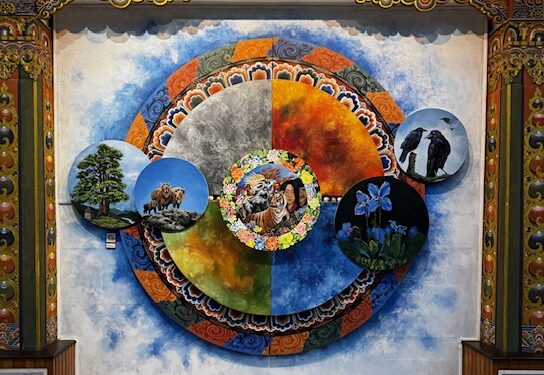
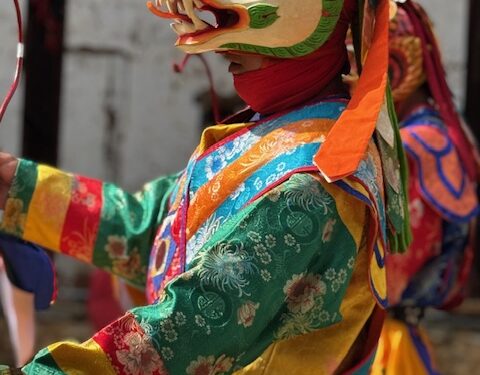
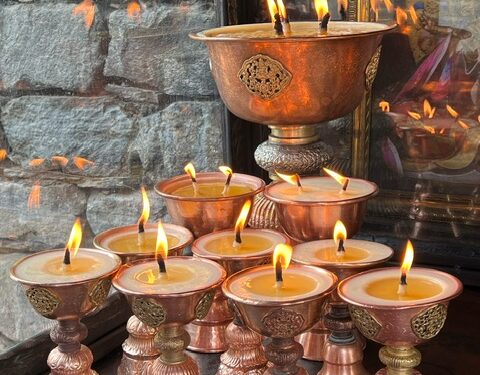



Loving this!
What a great trip! You both look fantastic and I’m thrilled to know you’re having a blast!
I could taste the gelato and smell the savory sent of ramen broth! How wonderful!
Once again you two have outdone yourselves! What a beautiful trip and I am so grateful you shared it!
Wow! What a fabulous trip! When we lived near Washington, D.C., we used to love going into the city to the Tidal Basin to see the Sakura springtime bloom. They were amazing, but what you experienced easily eclipsed the blooms we saw. Such history and so much fun food for you guys to enjoy – what a great experience!
I was there in Dec/Jan 1993–it definitely looks different. Your photos and description are wonderful.
You made me hungry! Thanks for taking me along with you to Japan.
I love your musing and trips. I get to visit all these fabulous places by reading about your adventures, love, love the photos. Thank our for sharing.
I can see you took full advantage of every opportunity in Tokyo! I love your glasses..I’ll bet Tequila would taste great in them or have you converted to Saki? What great photos and commentary. J
-im impressed with your organization as i am overwhelmed with all there is to see and do- from Ramen to Sakura- every step looks interesting and inviting- go go go !
Love reading about your world travels!
What a fabulous trip! I have to say Japan looks so interesting through your eyes, the photos make Tokyo come to life. Now I wanna go!
Oh, those Cherry Blossoms! What a marvelous introduction to Tokyo. Enjoyed everything from the Edo history to “Ramen Street.” Station City to Gelato. Tokyo Imperial Palace, to the enchanting Sumida River Walk Sakura, to Edo Kiriko (what fun!). All wonderfully narrated and beautifully photographed. Once again, thank you for taking me along…